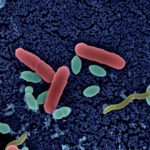Lien vers Pubmed [PMID] – 30225207
Biotechnol Rep (Amst) 2018 Dec;20:e00281
Microbes are prolific sources of bioactive molecules; however, the cultivability issue has severely hampered access to microbial diversity. Novel secondary metabolites from as-yet-unknown or atypical microorganisms from extreme environments have realistic potential to lead to new drugs with benefits for human health. Here, we used a novel approach that mimics the natural environment by using a Miniaturized Culture Chip allowing the isolation of several bacterial strains from Antarctic shallow water sediments under near natural conditions. A Gram-negative Antarctic bacterium belonging to the genus was subjected to further analyses. The sp. genome was sequenced and a bioinformatic approach was applied to identify biosynthetic gene clusters. The extract of the sp. showed antimicrobial and anthelmintic activity towards Multidrug resistant bacteria and the nematode . This is the first multi-approach study exploring the genomics and biotechnological potential of the genus that is a promising candidate for pharmaceutical applications.
[embeddoc url=”https://research.pasteur.fr/wp-content/uploads/2018/09/research_pasteur-isolation-by-miniaturized-culture-chip-of-an-antarctic-bacterium-sp-with-antimicrobial-and-anthelmintic-activity-biotechnology-reports-2018.pdf” download=”all” viewer=”google”]


